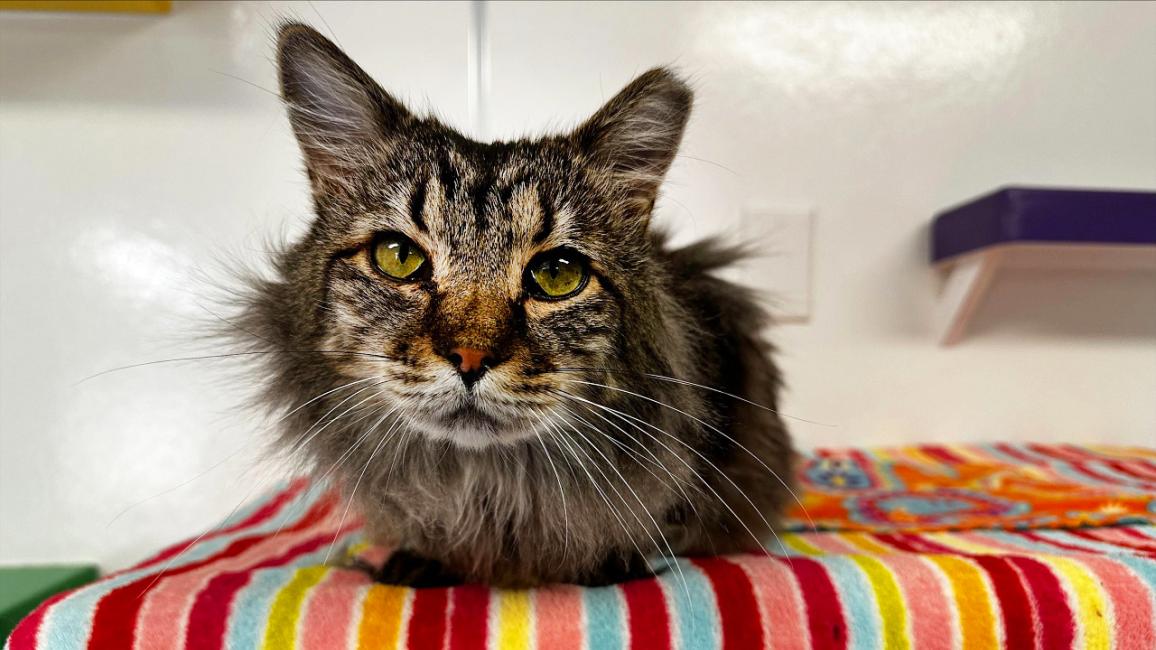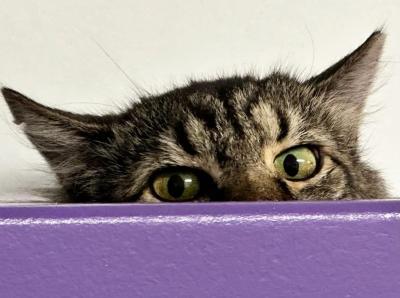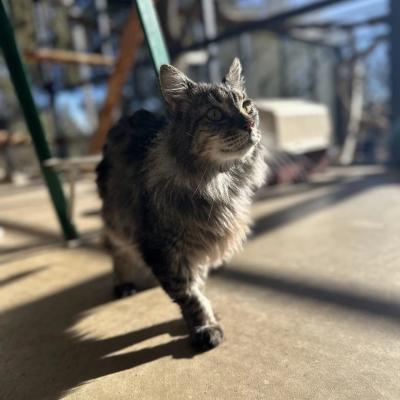Cat goes from hissy to happy once he’s feeling healthy

It can be hard to maintain a sunny disposition when your body is feeling bad. That goes for pets just as much as people — if not more so. They can’t just call up the vet when they’re not doing well; someone has to know to help them. So it’s no wonder that Waltz, when he landed at a shelter with a mouth painful from dental disease, wasn’t exactly leaping onto people’s laps for attention. His hissing and hiding were understandable. He did not feel good.
Things were looking up for the rightfully grouchy little guy though. Best Friends’ goal is for all shelters to reach no-kill in 2025, and that means working together to save pets who need extra time and care. And for Waltz, that meant arrangements were soon made for him to move to Best Friends Animal Sanctuary, where he’d get all the help he needed.
Transformation of a cantankerous kitty
“He was cranky,” Best Friends caregiver Patrick McMillan recalls of Waltz’s arrival. “He would just kind of sprawl out in the rafters and hiss at us when we got close.” It wasn’t a strange reaction, of course, for a cat in a brand-new place with brand-new people — especially one waiting for his date with a dental surgeon. No one took it personally.
As the countdown to his appointment ticked closer, caregivers let Waltz have his space to settle in. He wasn’t all grumbles and hisses. In fact, he watched passing people with a hint of curiosity, interested in their comings and goings. He may not have wanted to be touched or bothered when he was feeling so crummy, but his new human friends were hopeful he’d start opening up when his mouth didn’t hurt anymore. And they wouldn’t have to wait long to find out.
Waltz needed to have several teeth removed, so when he came back from the Sanctuary clinic, he had to be on a special diet for his healing mouth. “We made it a very good point, after his dental, to just keep giving him special meals,” says Patrick. Not only did the extra-yummy wet food mix help with giving Waltz his post-surgery pain medication, but the stomach is also, of course, often the fastest way to a cat’s heart.
[Freed from dental pain, senior cat regains vivacious spirit]
As he started feeling better and spending more time with his caregivers during recovery, Waltz quickly began warming up to them. He’d polish off his meals with them sitting and talking to him, and then he graduated to rumbling purrs when petted. Without pain cramping his style, Waltz transformed into a proper lovebug. He welcomed attention and interaction and even went looking for it sometimes — and his newfound comfort with his caregivers couldn’t have happened at a better time.
Because Waltz was out and about spending time with people, it didn’t take long for his caregivers to notice something else was starting to bring him back down. And it was even more serious.

Defeating a deadly virus
“His eyes started getting glassy,” Patrick explains, “and he had a mild upper respiratory infection that he just couldn’t shake.” Waltz’s symptoms weren’t severe — his face wasn’t messy with mucous — but he was clearly off. When Patrick voiced his concern at those early signs of illness, the veterinary team got Waltz back to the clinic that day.
Waltz tested positive for feline infectious peritonitis (FIP), a deadly viral disease that, until recently, had no treatment available to veterinarians in the United States. But Waltz’s infection had been caught early, and thanks to recent clinical trials, treatment was an option.
A move into a new area with other cats recovering from FIP didn’t shake Waltz’s newfound confidence either. He was only feeling a little under the weather, and once he was in treatment for the virus, he bounced back. And he was not about to give up all that attention he’d decided he enjoyed.
[Faces of No-Kill: Cat thrives after FIP treatment]
Now, Waltz is heading into the tail end of his FIP treatment, and no one could mistake him for a cranky cat these days. He’s bright and excited for visitors, exercising his squeaky little kitty voice to call out for scratches and snuggles and earning himself quite the reputation as a big sweetheart.
He’s feeling happy and healthy, and now soon it’ll be time for Waltz’s next exciting (though hopefully less harrowing) chapter of life: getting adopted into a home of his own.

Let's make every shelter and every community no-kill by 2025
Our goal at Best Friends is to support all animal shelters in the U.S. in reaching no-kill by 2025. No-kill means saving every dog and cat in a shelter who can be saved, accounting for community safety and good quality of life for pets.
Shelter staff can’t do it alone. Saving animals in shelters is everyone’s responsibility, and it takes support and participation from the community. No-kill is possible when we work together thoughtfully, honestly, and collaboratively.






